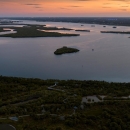Laws and Regulations
Refuge rules and regulations are necessary for the protection of visitors, wildlife and their habitats. Kirwin National Wildlife Refuge is subject to federal, state, and local laws and regulations. The Refuge is patrolled by Federal Law Enforcement Officers, State Game Wardens, and County Deputies. All violations of refuge regulations are subject to a fine, arrest, or both.
Please check with refuge management before participating in an activity that could harm the environment or yourself. Be safe and enjoy your National Wildlife Refuge.
Prohibited activities:
- Driving off-road and driving off-road utility vehicles (ORUV’s)
- Collecting plants, animals (including antlers), or historical artifacts
- Discharge of any firearm for any reason other than the legal taking of game animals
- Use of rifles and handguns
- Use or possession of air guns, spears, gigs, or other weapons
- Fireworks or explosives
- Overnight camping and fires
- Non-wildlife related activities
- Air thrust boats
- Commercial use, including guiding and fishing tournaments
- Free-roaming pets (pets must be on a leash except when hunting)
- Littering
- Possession or consumption of alcohol and controlled substances while hunting
- Firearms: Persons possessing, transporting, or carrying firearms on National Wildlife Refuge System lands must comply with all provisions of State and local law. Persons may only use (discharge) firearms in accordance with refuge regulations (50 CFR 27.42 and specific refuge regulations in 50 CFR Part 32.)
Hunting and Fishing Regulations
- Hunting and fishing are permitted in accordance with Federal regulations governing public use on National Wildlife Refuges as set forth in Title 50 of the Code of Federal Regulations.
- Hunting and fishing are allowed on the Refuge in accordance with State regulations and the Refuge-specific regulations in the hunting and fishing brochure.
- Hunting is allowed September 1 through April 30.
- Hunting hours are one-half hour before sunrise until one-half hour after sunset.
- Shotguns and archery equipment may be used in accordance with State regulations.
- Game may not be retrieved in an area closed to hunting for that species.
Game Regulations
- The Refuge is open to hunting in designated areas as shown on the map. Method of take is restricted to shotgun and archery equipment.
- See the Hunting Regulations Table in the Hunting and Fishing Brochure for a list of species that can be hunted on the Refuge, as well as Refuge-specific regulations.
Fishing Regulations
- All Refuge waters are open to sport fishing in accordance with State fishing regulations.
- A fish cleaning station is located next to the water tower in the town of Kirwin. Disposing of fish cleanings on the Refuge is considered littering and is subject to fines.
Boating
- Boating is allowed on all waters unless otherwise designated by signs or buoys. Float tubes may be used in areas open to boating.
- Boats must follow U.S. Coast Guard standards. They must be equipped and operated in accordance with Kansas Boat and Water Safety Laws and Federal regulations.
- Boating between October 1 and April 1 is prohibited if the lake elevation is 1,722 feet or less, with the exception of the area south of Scout Cove. Boats may be launched at the Bow Creek ramp at Scout Cove even during this time.
- A no wake zone is in effect within 100 yards of all shorelines and islands, as well as the entire Bow Creek Arm.
| Activity | Season Dates | Method of Take | Other Regulations |
|---|---|---|---|
| Big Game – Mule deer, white-tailed deer | State regulations apply | Archery only |
|
| Migratory Game Birds – Coot, crow, duck, goose, merganser, mourning dove, rail, snipe, woodcock | During State seasons that occur between September 1 – April 30 | Archery and shotgun |
|
| Upland Game – Bobwhite quail, pheasant, prairie chicken | State regulations apply | Archery and shotgun |
|
| Small Game – Cottontail rabbit, fox squirrel, gray squirrel, jackrabbit | September 1 – April 30 | Archery and shotgun |
|
| Turkey | State regulations apply | Archery and shotgun |
|
| Coyote | September 1 – April 30 | Archery and shotgun |
|
| Furbearer – Badger, bobcat, grey fox, mink, muskrat, opossum, red fox, swift fox, raccoon, striped skunk, weasel | September 1 – April 30 | Archery and shotgun |
|

